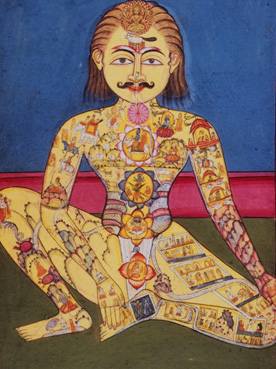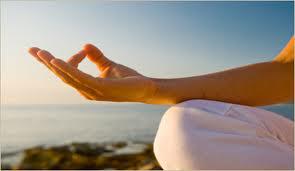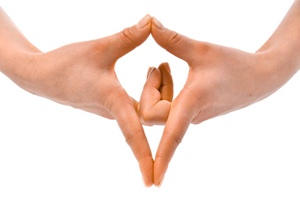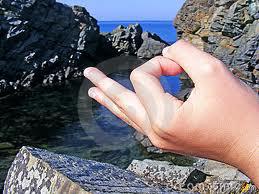MUDRAS

Yoga is about self-control and awareness of yourself, your body and your surroundings. Hatha yoga consists of postures, breathing, energy locks and energy seals. A mudra is an energy seal. It is a gesture or posture that allows us to control the flow of our energy or life force (prana). There are 25 major mudras in Hatha Yoga. Mudras are not restricted to hand gestures, but can be done with the eyes, body postures or take the form of cleansing rituals. The gestures themselves are symbolic of various states of consciousness. However, certain gestures can lead to the state of consciousness that they represent. So, practising a mudra can alter your state of consciousness.
Mudras are not confined to yoga. Some of them are international signs. Consider the ubiquitous handshake. What does it say? ‘Hello, pleased to meet you’. It is a physical touch with someone else, and in the old days it said ‘Look, I carry no weapon’. In ancient times the gods were called by raising both arms to the sky. As Christianity became powerful this gesture was prohibited and was then partially integrated into the Christian teachings during Mass. Hand gestures are prevalent in our lives today. When a friend goes for an interview we ‘hold thumbs’ for them. We clap at the theatre to sshow our appreciation. One of the first gestures and words that a small child learns to use together is to wave and say ‘bye bye’. We hold hands with our loved ones and some of us stick our middle finger into the air when another driver cuts us off. These gestures are understood by all and they carry certain energies.
Most of us enjoy watching Indian dancing but we have no idea that an intricate story is being woven by the dancer. All those hand an eye gestures are mudras and are recognised and interpreted by those that know what they mean.
Our hands, like our feet, are made up of reflex zones and are very sensitive. Our hands and feet contain more nerves and endocrine glands than any other part of our bodies. When we practice a hand mudra and connect the fingertips, palms and hands in certain ways we activate, redirect and recharge the energy of our entire being and the body’s energy is magnified. Everybody knows about chakras these days. They are very fashionable! They are energy centres in the body – much like the electricity substations found scattered around any city. However, every body also has 72 000 nadis. These are electric or pranic currents that run from the crown of the head to the toes of the feet and the tips of the fingers. One could compare the nadis to the power lines that supply our houses with electricity. (The major crossings of the nadis form the chakras). Mudras have an intense effect on the nadis. Each finger represents an element, a chakra, a planet, a body organ and an emotion. Each finger is also the ending of a meridian. Mudras can be enhanced with breathing exercises, mediation, mantras, colour, affirmations and music. The thumb is associated with the fire element, the lung meridian and the planet Mars and represents willpower and logic. The index finger is associated with the air element, the stomach meridian and the planet Jupiter. It represents the mind and the power of thought. The middle finger (not to be held up in the traffic) is associated with the ether element, the circulation and gallbladder meridians and the planet Saturn. It represents our spiritual path. Hindus call it the ‘heavenly finger’. The ring finger is associated with the earth element, the liver meridian and the sun (or Apollo, the sun god). It represents vitality and health. The little finger is associated with the water element, the heart meridian and the planet Mercury. It represents communication, sexuality and personal relationships. Our hands are important.
CHIN MUDRA

This gesture symbolises the connected nature of human consciousness. The circle formed by the index finger and thumb represents the true goal of yoga – the merging of the individual soul with the universal soul, or the soul of God. The nail of the index finger is placed into the first joint of the thumb. The last three fingers always face down towards the earth in this mudra. It is a gesture of receiving. When the finger touches the thumb a circuit is produced which allows the energy that would normally dissipate into the environment to travel back into the body, and up to the brain. When the fingers and hands are placed on the knees the knees are sensitised creating another pranic circuit that maintains and redirects prana within the body. In addition placing the hands on the knees stimulates a nadi, which runs from the knees up the inside of the thighs and into the perinium. Sensitising this channel helps stimulate the energies at the muladhara chakra. When the palms face upwards in the chin mudra the chest and heart area are opened up.
HRIDAYA MUDRA
This mudra diverts the flow of energy from the hands to the heart area. The middle and ring fingers relate directly to nadis connected to the heart, while the thumb closes the pranic circuit and acts as an energiser, diverting the flow of prana from the hands to these nadis. Hridaya mudra helps to release pent up emotion and unburden the heart.
YONI MUDRA
 The interlocking of the fingers in this practice creates a complete cross-connection of energies from the right hand to the left and vice versa. As well as balancing the energies in the body, it helps balance the activities of the left and right hemispheres of the brain.This mudra makes the body and mind more stable in meditation and developes greater concentration, awareness and internal physical relaxation. It redirects energy back into the body which would otherwise be dispersed. The word yoni means womb or source. The yoni mudra invokes the primal energy inherent in the womb or source of creation.
The interlocking of the fingers in this practice creates a complete cross-connection of energies from the right hand to the left and vice versa. As well as balancing the energies in the body, it helps balance the activities of the left and right hemispheres of the brain.This mudra makes the body and mind more stable in meditation and developes greater concentration, awareness and internal physical relaxation. It redirects energy back into the body which would otherwise be dispersed. The word yoni means womb or source. The yoni mudra invokes the primal energy inherent in the womb or source of creation.
JNANA MUDRA
Jnana is Sanskrit for wisdom, so this mudra is the psychic gesture of knowledge.


 Return to menu
Return to menu